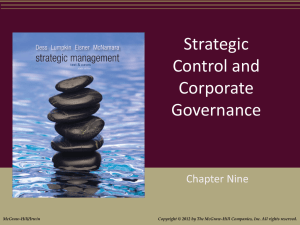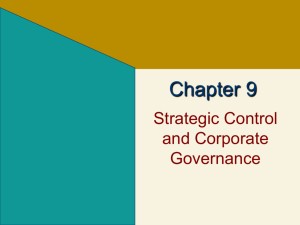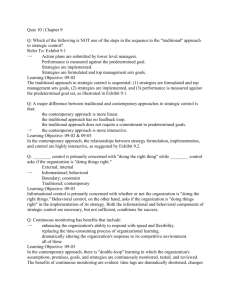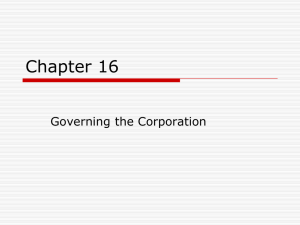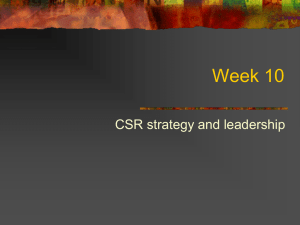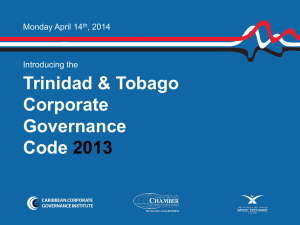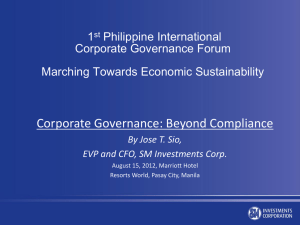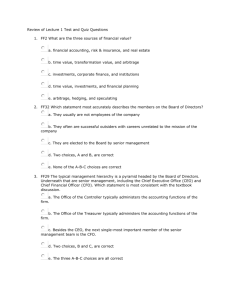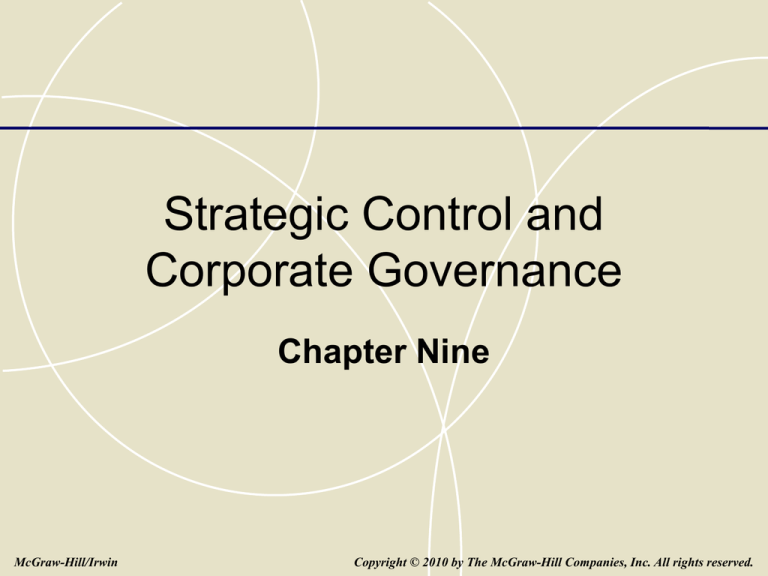
Strategic Control and
Corporate Governance
Chapter Nine
McGraw-Hill/Irwin
Copyright © 2010 by The McGraw-Hill Companies, Inc. All rights reserved.
Strategic Control
• Strategic control
the process of monitoring and correcting a
firm’s strategy and performance
Informational, behavioral
9-2
Ensuring Informational Control
• Traditional control system
1. strategies are formulated and top
management sets goals
2. strategies are implemented
3. performance is measured against the
predetermined goal set
9-3
Traditional Approach
to Strategic Control
• Most appropriate when
Environment is stable and relatively simple
Goals and objectives can be measured with
certainty
Little need for complex measures of
performance
9-4
Contemporary Approach to Strategic
Control
• Contemporary control system
Continually monitoring the environments
(internal and external)
Identifying trends and events that signal the
need to revise strategies, goals and
objectives
9-5
Contemporary Approach
to Strategic Control
• Informational
control
Concerned with
whether or not the
organization is “doing
the right things”
• Behavioral control
Concerned with
whether or not the
organization is “doing
things right” in the
implementation of its
strategy
9-6
Informational Control
• Two key issues
Scan and monitor external environment
(general and industry)
Continuously monitor the internal
environment
9-7
Effectiveness of Contemporary Control
Systems
1. Focus on constantly changing information that
has potential strategic importance.
2. The information is important enough to demand
frequent and regular attention from all levels of
the organization.
3. The data and information generated are best
interpreted and discussed in face-to-face
meetings.
4. The control system is a key catalyst for an
ongoing debate about underlying data,
assumptions, and action plans.
9-8
Behavioral Control
• Behavioral control is focused on
implementation—doing things right
• Three key control “levers”
Culture
Rewards
Boundaries
9-9
Reasons for an increased emphasis on
culture and rewards
1. The competitive
environment is
increasingly
complex and
unpredictable,
demanding both
flexibility and quick
response to its
challenges.
2. The implicit longterm contract
between the
organization and its
key employees has
been eroded.
9-10
Building a Strong and Effective
Culture
• Organizational culture
a system of shared values and beliefs that
shape a company’s people, organizational
structures, and control systems to produce
behavioral norms.
9-11
Building a Strong and Effective
Culture
• Culture sets implicit boundaries (unwritten
standards of acceptable behavior)
Dress
Ethical matters
The way an organization conducts its
business
9-12
Motivating with Rewards and
Incentives
• Rewards and incentive systems
Powerful means of influencing an
organization’s culture
Focuses efforts on high-priority tasks
Motivates individual and collective task
performance
Can be an effective motivator and control
mechanism
9-13
Motivating with Rewards and
Incentives
• Potential downside
Subcultures may arise in different business
units with multiple reward systems
May reflect differences among functional
areas, products, services and divisions
9-14
Setting Boundaries and Constraints
• Focus efforts on strategic priorities
• Providing short-term objectives and action
plans
Specific and measurable
Specific time horizon for attainment
Achievable, but challenging
9-15
Role of Corporate Governance
• Corporate governance
the relationship among various participants in
determining the direction and performance of
corporations.
primary participants are the shareholders, the
management, and the board of directors.”
9-16
Agency Theory
• Deals with the relationship between
Principals – who are owners of the firm
(stockholders), and the
Agents – who are the people paid by
principals to perform a job on their behalf
(management)
9-17
Agency Theory: Two Problems
1. The conflicting
goals of principals
and agents, along
with the difficulty of
principals to monitor
the agents, and
2. The different
attitudes and
preferences towards
risk of principals and
agents.
9-18
Governance Mechanisms
• Board of directors
a group that has a fiduciary duty to ensure
that the company is run consistently with the
long-term interests of the owners, or
shareholders, of a corporation and that acts
as an intermediary between the shareholders
and management.
9-19
Governance Mechanisms
• Shareholder activism
actions by large shareholders, both
institutions and individuals, to protect their
interests when they feel that managerial
actions diverge from shareholder value
maximization.
9-20
TIAA-CREF’s Principles on the Role of Stock
in Executive Compensation
9-21
External Governance
Control Mechanisms
•
•
•
•
•
Market for corporate control
Auditors
Banks and analysts
Regulatory bodies
Media and public activists
9-22
Sarbanes-Oxley Act
• Auditors
Barred from certain types of non-audit work
Not allowed to destroy records for five years
Lead partners auditing a firm should be
changed at least every five years
9-23
Sarbanes-Oxley Act
• CEOs and CFOs
Must fully reveal off-balance sheet finances
Vouch for the accuracy of information
revealed
• Executives
Must promptly reveal the sale of shares in
firms they manage
Are not allowed to sell shares when other
employees cannot
9-24

